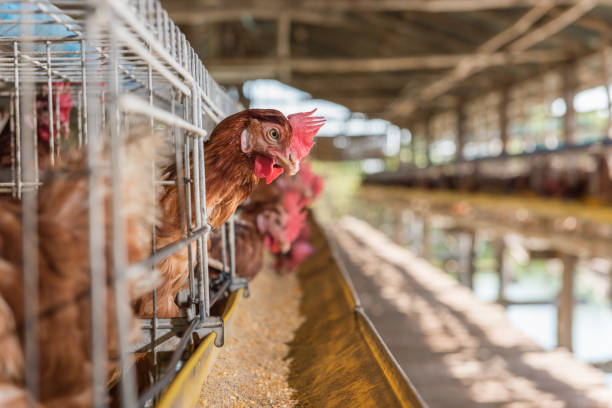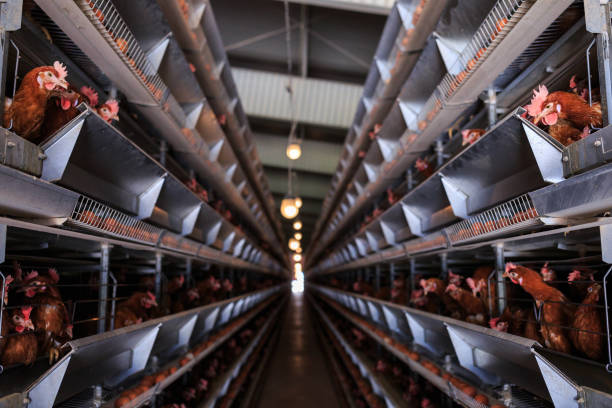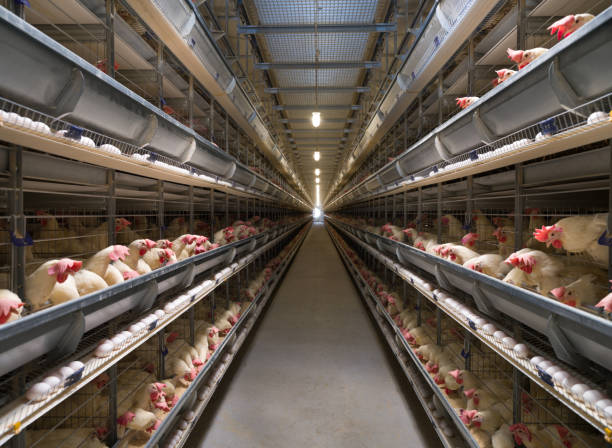
Affordable Open House Battery Cage Solutions: Boosting Poultry Production in Africa
Affordable Open House Battery Cage Solutions: Boosting Poultry Production in Africa
Africa’s poultry industry is on the rise, and with it comes the need for efficient and cost-effective farming methods. The open house battery cage system has emerged as a popular solution, offering a blend of affordability and productivity. This article explores how open house battery cages can revolutionize poultry production in Africa, addressing the specific challenges and opportunities presented by the continent’s diverse agricultural landscape.
Understanding Open House Battery Cages
Before diving into the African context, let’s clarify what open house battery cages are all about. Essentially, these systems involve housing chickens in tiered cages within a naturally ventilated building. “Open house” refers to the building’s design, which relies on natural airflow and sunlight instead of sophisticated climate control systems.
Each cage is designed to comfortably accommodate several birds, providing them with access to feed and water. Eggs, in the case of layer hens, roll automatically to collection trays. Waste management can range from manual scraping to automated belt systems, depending on the farmer’s budget and preferences.
Why Open House Systems are Gaining Traction in Africa
Open house battery cage systems offer a compelling proposition for African poultry farmers, primarily due to their affordability and adaptability. Here’s a breakdown of the key advantages:
Lower Initial Investment: Compared to fully enclosed, climate-controlled poultry houses, open house systems require significantly less upfront capital. This is a crucial factor for farmers with limited resources. The lower cost stems from the reduced need for complex ventilation, heating, and cooling equipment. Construction is simpler, and locally sourced materials can often be used, further reducing expenses.
Reduced Operating Costs: The reliance on natural ventilation and sunlight translates to lower energy bills. This is particularly important in regions where electricity is expensive or unreliable. Farmers can also reduce labor costs by implementing semi-automatic or automatic systems for feeding, drinking, manure removal and egg collection.
Adaptability to Climate: While extreme climates pose challenges, open house systems can be adapted to suit a wide range of African environments. Simple modifications like shade nets, strategically placed trees, and roof insulation can help mitigate the effects of intense heat or cold. The open design allows for better air circulation, reducing humidity and the risk of disease outbreaks.

Improved Bird Welfare: The larger space and good ventilation in battery cages promote bird welfare, reducing the chances of disease incidence and stress levels.
Increased Egg Production: Birds housed under proper conditions result in high egg production, thus maximizing returns on investment.
Enhanced Manure Management: The design of battery cage farms simplifies manure management, enabling easy collection and disposal. This is not only essential for hygiene but also for turning manure into valuable fertilizer.
Specific Considerations for Implementing Open House Systems in Africa
While open house battery cages offer numerous benefits, successful implementation requires careful planning and adaptation to local conditions. Here are some key considerations:
Climate Control Strategies: In regions with extreme temperatures, additional measures may be necessary to maintain a comfortable environment for the birds. This could include:
Shade Nets: Providing shade over the poultry house can significantly reduce the internal temperature.
Roof Insulation: Insulating the roof helps to prevent heat from entering the building during the day and retain heat during the night.
Sprinkler Systems: Evaporative cooling systems can be used to lower the temperature of the air entering the poultry house.
Proper Ventilation: Ensuring adequate airflow is crucial for removing moisture and heat.
Predator Control: Protecting the birds from predators is essential, especially in rural areas. This can be achieved through:
Secure Fencing: A strong perimeter fence can deter predators from entering the poultry farm.
Netting: Covering the open sides of the poultry house with netting can prevent birds from escaping and keep predators out.
Guard Animals: Dogs or other guard animals can provide an additional layer of protection.
Disease Prevention: Maintaining good hygiene and biosecurity practices is crucial for preventing disease outbreaks. This includes:
Regular Cleaning and Disinfection: The poultry house should be regularly cleaned and disinfected to prevent the build-up of pathogens.
Vaccination Programs: Implementing a comprehensive vaccination program can protect the birds from common poultry diseases.
Biosecurity Measures: Restricting access to the poultry farm and implementing strict hygiene protocols can help to prevent the introduction of disease.
Feed and Water Management: Providing the birds with adequate feed and water is essential for optimal growth and egg production. This includes:
High-Quality Feed: The feed should be formulated to meet the specific nutritional needs of the birds.
Clean Water: The water should be clean and free from contaminants.
Adequate Feeders and Drinkers: There should be enough feeders and drinkers to ensure that all birds have access to feed and water.
Waste Management: Proper waste management is essential for maintaining hygiene and preventing environmental pollution. This includes:

Regular Manure Removal: The manure should be removed from the poultry house regularly.
Composting or Other Treatment: The manure can be composted or treated in other ways to reduce its environmental impact.
Proper Storage: The manure should be stored in a way that prevents it from contaminating water sources.
Choosing the Right Cage System: There are various types of battery cage systems available, and it’s essential to select a system that is appropriate for the specific needs of the farmer. Factors to consider include:
Cage Size and Capacity: The cage size and capacity should be appropriate for the breed of birds being raised.
Materials: The cage should be made of durable materials that are easy to clean and disinfect.
Automation: The level of automation should be appropriate for the farmer’s budget and labor availability.
Egg Collection System: Choose a system that is efficient and minimizes egg breakage.
Local Regulations and Permits: Before setting up a poultry farm, it’s essential to check with local authorities to ensure that all necessary regulations and permits are obtained.
Case Studies: Success Stories in Africa
While the challenges are real, numerous African poultry farmers have successfully adopted open house battery cage systems, demonstrating their potential for boosting production and improving livelihoods. Here are a few examples:
Smallholder Farmers in Kenya: Many smallholder farmers in Kenya have transitioned from traditional free-range systems to open house battery cages. This has allowed them to increase their flock size, improve egg production, and access larger markets. The increased income has enabled them to improve their living standards and invest in their farms. They have also learned and adapted on disease control and ventilation during extreme weather.
Commercial Poultry Farms in Nigeria: Larger commercial poultry farms in Nigeria have also embraced open house battery cages, attracted by their cost-effectiveness and scalability. These farms have been able to achieve significant economies of scale, reducing their production costs and increasing their profitability. Their ability to buy feed and other inputs in bulk has given them a significant advantage in the market.
Women-Owned Poultry Businesses in Uganda: Open house battery cages have empowered women in Uganda to start and grow their own poultry businesses. The relatively low initial investment and manageable operating costs make these systems accessible to women with limited resources. These businesses have provided women with a source of income and improved their economic independence.
The Future of Poultry Production in Africa: Open House Battery Cages as a Catalyst
Open house battery cage systems have the potential to play a significant role in the future of poultry production in Africa. By providing an affordable and adaptable solution for housing chickens, these systems can help to:

Increase Poultry Production: Meeting the growing demand for poultry products in Africa.
Improve Food Security: Making poultry products more accessible and affordable to consumers.
Empower Farmers: Providing farmers with a sustainable and profitable source of income.
Create Jobs: Creating employment opportunities in the poultry industry and related sectors.
Reduce Poverty: Lifting families out of poverty and improving their living standards.
To fully realize the potential of open house battery cage systems in Africa, it is essential to:
Provide Farmers with Training and Support: Equipping farmers with the knowledge and skills they need to operate their poultry farms successfully.
Improve Access to Finance: Providing farmers with access to affordable credit to invest in their poultry farms.
Strengthen Infrastructure: Improving transportation and storage infrastructure to reduce post-harvest losses.
Promote Market Linkages: Connecting farmers with buyers and processors to ensure that they can sell their products at fair prices.
Encourage Research and Development: Investing in research and development to improve the efficiency and sustainability of open house battery cage systems.
In conclusion, open house battery cage systems represent a practical and affordable solution for boosting poultry production in Africa. By addressing the specific challenges and opportunities presented by the continent’s diverse agricultural landscape, these systems can help to improve food security, empower farmers, and create a more prosperous future for Africa.
